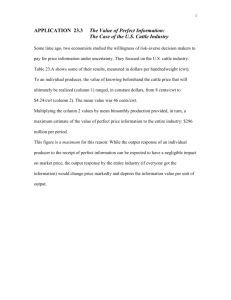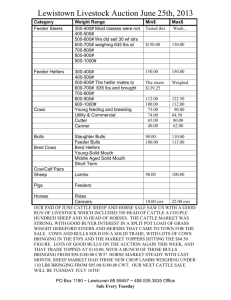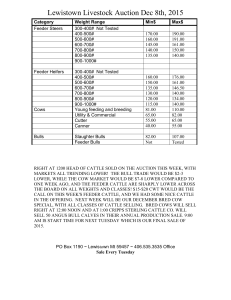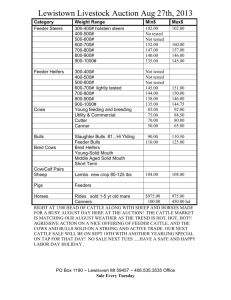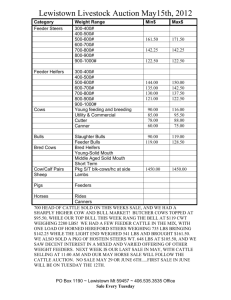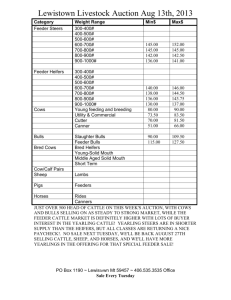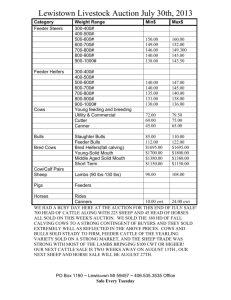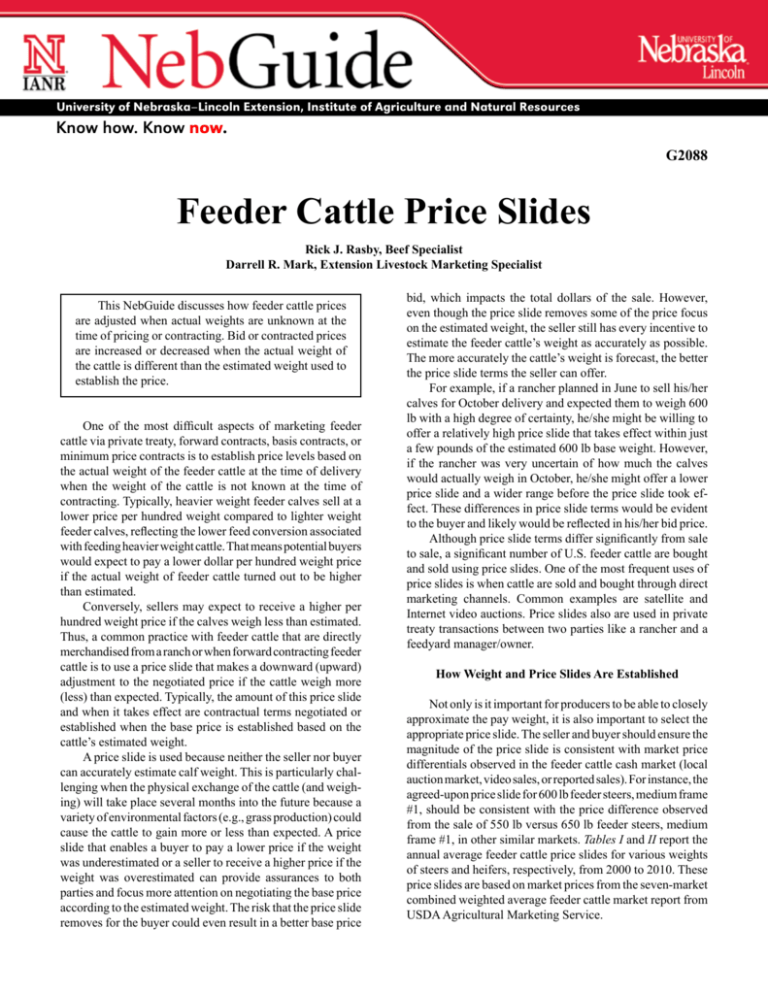
®
®
University of Nebraska–Lincoln Extension, Institute of Agriculture and Natural Resources
Know how. Know now.
G2088
Feeder Cattle Price Slides
Rick J. Rasby, Beef Specialist
Darrell R. Mark, Extension Livestock Marketing Specialist
This NebGuide discusses how feeder cattle prices
are adjusted when actual weights are unknown at the
time of pricing or contracting. Bid or contracted prices
are increased or decreased when the actual weight of
the cattle is different than the estimated weight used to
establish the price.
One of the most difficult aspects of marketing feeder
cattle via private treaty, forward contracts, basis contracts, or
minimum price contracts is to establish price levels based on
the actual weight of the feeder cattle at the time of delivery
when the weight of the cattle is not known at the time of
contracting. Typically, heavier weight feeder calves sell at a
lower price per hundred weight compared to lighter weight
feeder calves, reflecting the lower feed conversion associated
with feeding heavier weight cattle. That means potential buyers
would expect to pay a lower dollar per hundred weight price
if the actual weight of feeder cattle turned out to be higher
than estimated.
Conversely, sellers may expect to receive a higher per
hundred weight price if the calves weigh less than estimated.
Thus, a common practice with feeder cattle that are directly
merchandised from a ranch or when forward contracting feeder
cattle is to use a price slide that makes a downward (upward)
adjustment to the negotiated price if the cattle weigh more
(less) than expected. Typically, the amount of this price slide
and when it takes effect are contractual terms negotiated or
established when the base price is established based on the
cattle’s estimated weight.
A price slide is used because neither the seller nor buyer
can accurately estimate calf weight. This is particularly challenging when the physical exchange of the cattle (and weighing) will take place several months into the future because a
variety of environmental factors (e.g., grass production) could
cause the cattle to gain more or less than expected. A price
slide that enables a buyer to pay a lower price if the weight
was underestimated or a seller to receive a higher price if the
weight was overestimated can provide assurances to both
parties and focus more attention on negotiating the base price
according to the estimated weight. The risk that the price slide
removes for the buyer could even result in a better base price
bid, which impacts the total dollars of the sale. However,
even though the price slide removes some of the price focus
on the estimated weight, the seller still has every incentive to
estimate the feeder cattle’s weight as accurately as possible.
The more accurately the cattle’s weight is forecast, the better
the price slide terms the seller can offer.
For example, if a rancher planned in June to sell his/her
calves for October delivery and expected them to weigh 600
lb with a high degree of certainty, he/she might be willing to
offer a relatively high price slide that takes effect within just
a few pounds of the estimated 600 lb base weight. However,
if the rancher was very uncertain of how much the calves
would actually weigh in October, he/she might offer a lower
price slide and a wider range before the price slide took effect. These differences in price slide terms would be evident
to the buyer and likely would be reflected in his/her bid price.
Although price slide terms differ significantly from sale
to sale, a significant number of U.S. feeder cattle are bought
and sold using price slides. One of the most frequent uses of
price slides is when cattle are sold and bought through direct
marketing channels. Common examples are satellite and
Internet video auctions. Price slides also are used in private
treaty transactions between two parties like a rancher and a
feedyard manager/owner.
How Weight and Price Slides Are Established
Not only is it important for producers to be able to closely
approximate the pay weight, it is also important to select the
appropriate price slide. The seller and buyer should ensure the
magnitude of the price slide is consistent with market price
differentials observed in the feeder cattle cash market (local
auction market, video sales, or reported sales). For instance, the
agreed-upon price slide for 600 lb feeder steers, medium frame
#1, should be consistent with the price difference observed
from the sale of 550 lb versus 650 lb feeder steers, medium
frame #1, in other similar markets. Tables I and II report the
annual average feeder cattle price slides for various weights
of steers and heifers, respectively, from 2000 to 2010. These
price slides are based on market prices from the seven-market
combined weighted average feeder cattle market report from
USDA Agricultural Marketing Service.
Table I. Annual average feeder steer price slides, by weight category.
Year
250-350 lb
Slide
($/cwt)
350-450
Slide
($/cwt)
450-550
Slide
($/cwt)
550-650
Slide
($/cwt)
650-750
Slide
($/cwt)
750-850
Slide
($/cwt)
850-950
Slide
($/cwt)
2000
0.09
0.08
0.08
0.10
0.07
0.05
0.05
2001
0.07
0.08
0.09
0.09
0.07
0.04
0.04
2002
0.04
0.10
0.09
0.07
0.05
0.04
0.05
2003
0.09
0.01
0.18
0.08
0.05
0.04
0.03
2004
0.12
0.11
0.10
0.10
0.07
0.05
0.05
2005
0.17
0.15
0.12
0.12
0.09
0.06
0.06
2006
0.18
0.15
0.13
0.11
0.08
0.05
0.06
2007
0.08
0.10
0.09
0.09
0.06
0.04
0.04
2008
0.07
0.07
0.07
0.08
0.06
0.03
0.04
2009
0.09
0.05
0.08
0.08
0.06
0.04
0.04
2010
0.03
0.10
0.07
0.08
0.07
0.05
0.04
Table II. Annual average feeder heifer price slides, by weight category.
Year
250-350 lb
Slide
($/cwt)
350-450
Slide
($/cwt)
450-550
Slide
($/cwt)
550-650
Slide
($/cwt)
650-750
Slide
($/cwt)
750-850
Slide
($/cwt)
850-950
Slide
($/cwt)
2000
0.05
0.08
0.08
0.06
0.04
0.04
0.03
2001
0.09
0.09
0.09
0.07
0.04
0.04
—
2002
0.05
0.08
-0.09
0.22
0.04
0.03
—
2003
0.05
0.08
0.08
-0.03
0.11
0.03
0.04
2004
0.13
0.10
0.09
0.08
-0.01
0.11
0.06
2005
0.15
0.11
0.12
0.09
0.07
0.06
0.04
2006
0.09
0.13
0.11
0.09
0.07
0.05
0.04
2007
0.05
0.09
0.08
0.06
0.04
0.02
0.04
2008
0.03
0.06
0.06
0.05
0.03
0.02
0.04
2009
0.04
0.05
0.06
0.05
0.04
0.03
0.04
2010
0.02
0.05
0.06
0.07
0.05
0.03
0.05
Note that the feeder cattle price slides differ according to
the cattle’s weight and sex. Both Table I and II suggest that
the price slide is typically larger for lighter weight feeder
cattle than for heavier weight feeders. This is because the
value of 1 pound of weight is higher for lighter weight cattle
since the feed conversion for those lighter cattle is better
(lower). Similarly, because heavier feeder cattle tend to
have poorer (higher) feed conversion, a marginal pound of
weight on those cattle is less valuable. Also observe that in
comparing the steer and heifer price spreads in Tables I and
II, respectively, the price slides for the steers are typically
larger than for heifers. Again, this is due to steers typically
having better feed conversion relative to heifers of the same
weight.
Not only do price slides change according to weight and
sex, they are also sensitive to grade, breed, location, corn
price, and fed cattle prices, just like base prices. For example,
higher corn prices typically result in smaller discounts for
heavier weight feeders relative to light feeders because weight
gain is more expensive. Dhuyvetter, Schroeder, and Prevatt
(2001) discuss the impacts of corn and fed cattle prices on
feeder cattle price slides.
Because price slides are affected by these market conditions, it is important to determine the price slide in a contract
according to current market conditions. The price slide is
calculated by dividing the difference in market price by the
corresponding difference in the feeder cattle’s weight. For
example, calculating a price slide for feeder steer calves of
similar quality weighing from 500-550 lb (average = 525 lb)
with a market price of $131/cwt to 550-600 lb with a market
price of $124/cwt (average = 575 lb), the corresponding
market price difference would be $7.00/cwt for a weight
difference of 50 lb (575 - 525). Therefore, the price slide
calculates to $14.00/cwt or 14 cents per pound ($7.00/cwt
÷ 0.5 cwt).
Examples Using a Price Slide
Cattle often are sold using a price slide because they
can’t be conveniently weighed at their current location where
they are being sold FOB (i.e., free on board, meaning that the
buyer pays all transportation costs, including shrink, beyond
that point). This is especially common when feeder calves
are sold using a video or Internet auction and transported
to the buyer’s location some time after the actual sale date.
Shrink is the weight that cattle lose when they are not
allowed access to feed or water. Shrink can occur during penning, sorting, weighing, and transporting. The loss in weight
due to shrink is commonly from urine and manure excretion
during the processes described previously. To minimize the
effect of gut fill on sale weight, a “shrink” factor is usually
negotiated at the time of sale. Shrink weight is subtracted
from the pay weight that is delivered to the buyer.
Common shrink or “pencil” shrink that is used in the
industry is 2 to 4 percent of the delivered weight. Typically,
the pencil shrink is lower if the cattle will be weighed farther
from the FOB point because more time will have elapsed
and gut fill may have decreased more. Further, the shrink
factor will depend on how the cattle have been handled
prior to loading on the truck (e.g., gathering, sorting, dry
lotting, etc.) and whether they are weighed on the truck or
are unloaded for weighing. This shrink weight is generally
subtracted from the cattle’s actual weight to determine the
pay weight upon which the price slide is applied.
As suggested above, price slides may not be immediately
applied when the actual pay weight differs from the estimated
base weight upon which price was negotiated. Often, a
“window” around the estimated base weight is created where
the price slide doesn’t apply. For example, a seller estimates
the base weight of the cattle to be 550 lb and offers a 7 cent
slide for every pound beyond 10 lb over or under the base
weight. In this case, no price slide would be applied when
the actual pay weight is between 540 and 560 lb.
Additionally, it is common for the price slide to only be
used when the actual pay weight exceeds the estimated base
weight (by the window). In other words, the negotiated base
price is only lowered when the actual pay weight exceeds
the estimated base weight. It is not increased if the actual
weight is lower than the base weight. Such terms favor the
buyer; however, many sellers offer these price slide terms
to attract potential buyers. As in the previous example, one
of the most common price slide terms used in the industry
is a slide of x cents per lb for every pound exceeding 10 lb
over the base weight.
If calves are marketed using a price slide, buyer and
seller must arrive at an estimated base weight that is expected to be delivered, a calculated pencil shrink, weighing
conditions, a delivery date, a bid price, and a price slide to
adjust sale price if the delivery weight is more or less than
the predetermined sale weight.
Example: Actual pay weight is greater than estimated
base weight
Estimated base weight = 550 lb per steer
Slide = $5.00/cwt over 10 lb over the base weight
Shrink = 2%
Bid price = $1.45/lb = $145/cwt
Actual physical weight at delivery = 600 lb per steer
The price slide will be used because the actual delivered
weight is greater than the estimated base weight. The bid price
of $145/cwt was for 550 lb steers and the actual weight of
the steers was 600 lb. The price for the 600 lb steers will be
lower than for the 550 lb steers.
Shrink = 600 × 0.02 = 12 lb
Pay weight = 600 - 12 = 588 lb
Weight subject to the price slide = 588 lb - 560 = 28 lb =
0.28/cwt
Price slide adjustment = 0.28 cwt × $5.00/cwt = $1.40/cwt
Adjusted sale price = $145 - $1.40 = $143.60/cwt
Sale price per steer = 588 cwt × $143.60 = $844.37 per steer
The price slide was based using 560 lb as there was a
10 lb window on either side of the estimated pay weight that
was agreed to at the time of the sale. The pounds within the
window are not subject to the price slide (550 lb ± 10 lb =
560 to 540 lb = 20 lb); therefore, 550 lb + 10 lb = 560 lb.
The extra 28 lb (0.28 cwt) is multiplied by the price slide to
arrive at the price slide adjustment. The $1.40 is subtracted
from the negotiated bid price to arrive at the adjusted sale
price of $143.60/cwt. Multiply the adjusted sale price by the
pay weight to get to the final sale price per head.
Example: Actual pay weight is less than estimated base
weight
Estimated base weight = 500 lb per steer
Slide = $10.00/cwt over/under 10 lb over/under the base
weight
Shrink = 3%
Bid price = $1.55/lb = $155/cwt
Actual physical weight at delivery = 435 lb per steer
The price slide will be used because the actual physical delivered weight is more than 10 lb under the estimated
base weight. Note that this example allows for an upward
adjustment to the base price, unlike the previous example.
The bid price of $155/cwt was for 500 lb steers and the
delivered weight was 435 lb. The price for the 435 lb steers
will be more than the 500 lb steers.
Shrink = 435 × 0.03 = 13 lb
Pay weight = 435 - 13 = 422 lb
Weight subject to the price slide = 490 lb - 422 = 68 lb =
0.68 cwt
Price slide adjustment = 0.68 cwt × $10.00/cwt = $6.80
Adjusted sale price = $155 + $6.80 = $161.80
Sale price per steer = 4.22 cwt × $161.80 = $682.80
The price slide was based using 490 lb because a 10 lb
window on either side of the estimated pay weight was agreed
to at the time of the sale. The pounds within the window
are not subject to the price slide (500 lb ± 10 lb = 510 to
490 lb = 20 lb); therefore, 500 lb - 10 lb = 490 lb. The 68
lb is multiplied by the price slide to arrive at the price slide
adjustment. The $6.80 is added to the negotiated bid price
to arrive at the adjusted sale price of $161.80/cwt. Note that
in this example, had the price slide only applied to weights
exceeding the base weight, no price adjustment would have
been made. The pencil shrink would have applied­, though. In
this case, the price paid is $654.10/head (4.22 cwt × $155/cwt).
Resources
Dhuyvetter, K.C., T. Schroeder, and W. Prevatt. The Impact
of Corn and Fed Cattle Prices on Feeder Cattle Price
Slides. Kansas State University Agricultural Experiment
Station and Cooperative Extension Service. MF-2504.
April 2001. Available online at http://www.agmanager.
info/livestock/marketing/bulletins_2/marketing/feeder_
cattle/mf2504.pdf.
U.S. Department of Agriculture (USDA). Agricultural Marketing Service. Nebraska Weekly Feeder Cattle Auction
Summary. WH_LS795, various issues. (1999-2010).
This publication has been peer reviewed.
UNL Extension publications are available online
at http://extension.unl.edu/publications.
Index: Beef
Business Management
Issued June 2011
Extension is a Division of the Institute of Agriculture and Natural Resources at the University of Nebraska–Lincoln
cooperating with the Counties and the United States Department of Agriculture.
University of Nebraska–Lincoln Extension educational programs abide with the nondiscrimination policies
of the University of Nebraska–Lincoln and the United States Department of Agriculture.
© 2011, The Board of Regents of the University of Nebraska on behalf of the University of Nebraska–Lincoln Extension. All rights reserved.

